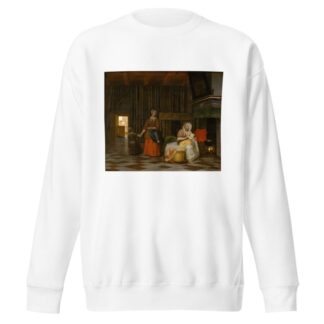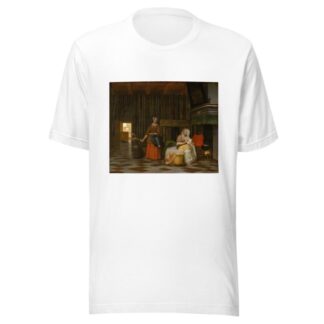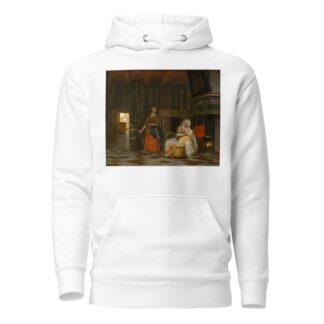Description
Woman and Child with Serving Maid by Pieter De Hooch printed on a Hoodie
About the Hoodie
Modern fit
It provides a more tailored look than a regular fit
Comfortable
The fabric and fit of this item are extra comfy
Tear-away tag
Easily removable tear-away tag that allows you to add a custom inside label
Premium quality
The product is made from premium, high-quality materials
Classic unisex hoodie with a front pouch pocket and matching flat drawstrings. The 100% cotton exterior makes this hoodie soft to the touch.
- 65% ring-spun cotton, 35% polyester
- Charcoal Heather is 60% ring-spun cotton, 40% polyester
- Carbon Grey is 55% ring-spun cotton, 45% polyester
- 100% cotton face
- Fabric weight: 8.5 oz./yd.² (288.2 g/m²)
- Front pouch pocket
- Self-fabric patch on the back
- Matching flat drawstrings
- 3-panel hood
- Tear-away tag
Pieter De Hooch (1629-1684)
Pieter de Hooch was a Dutch Golden Age painter famous for his genre works of quiet domestic scenes with an open doorway. He was a contemporary of Jan Vermeer in the Delft Guild of St. Luke, with whom his work shares themes and style.
De Hooch was born in Rotterdam to Hendrick Hendricksz de Hooch, a bricklayer, and Annetge Pieters, a midwife. He was the eldest of five children and outlived all of his siblings. Little is known of his early life and most archival evidence suggests he worked in Rotterdam, Delft, and Amsterdam. According to his first biographer Arnold Houbraken, he studied art in Haarlem under the landscape painter Nicolaes Berchem at the same time as Jacob Ochtervelt and was known for his “kamergezichten” or “room-views” with ladies and gentlemen in conversation.
The early work of de Hooch was mostly composed of scenes of soldiers and peasants in stables and taverns in the manner of Adriaen van Ostade, though he used these to develop great skill in light, color, and perspective rather than to explore an interest in the subject matter.
After starting his family in the mid-1650s, he switched his focus to domestic scenes. These were possibly of his own family, though his works of well-to-do women breastfeeding and caring for children could also indicate that he had attended his mother on her rounds as a midwife.






Reviews
There are no reviews yet.